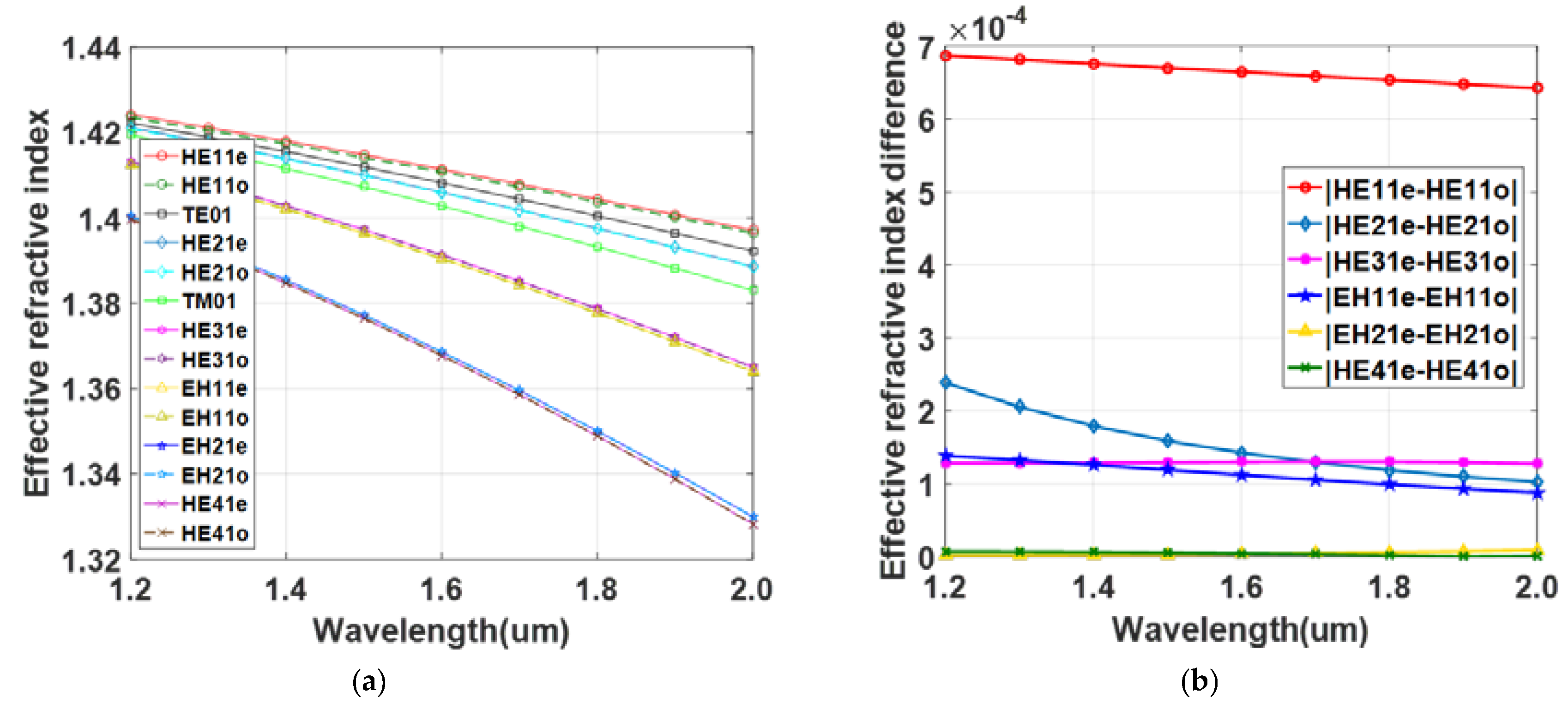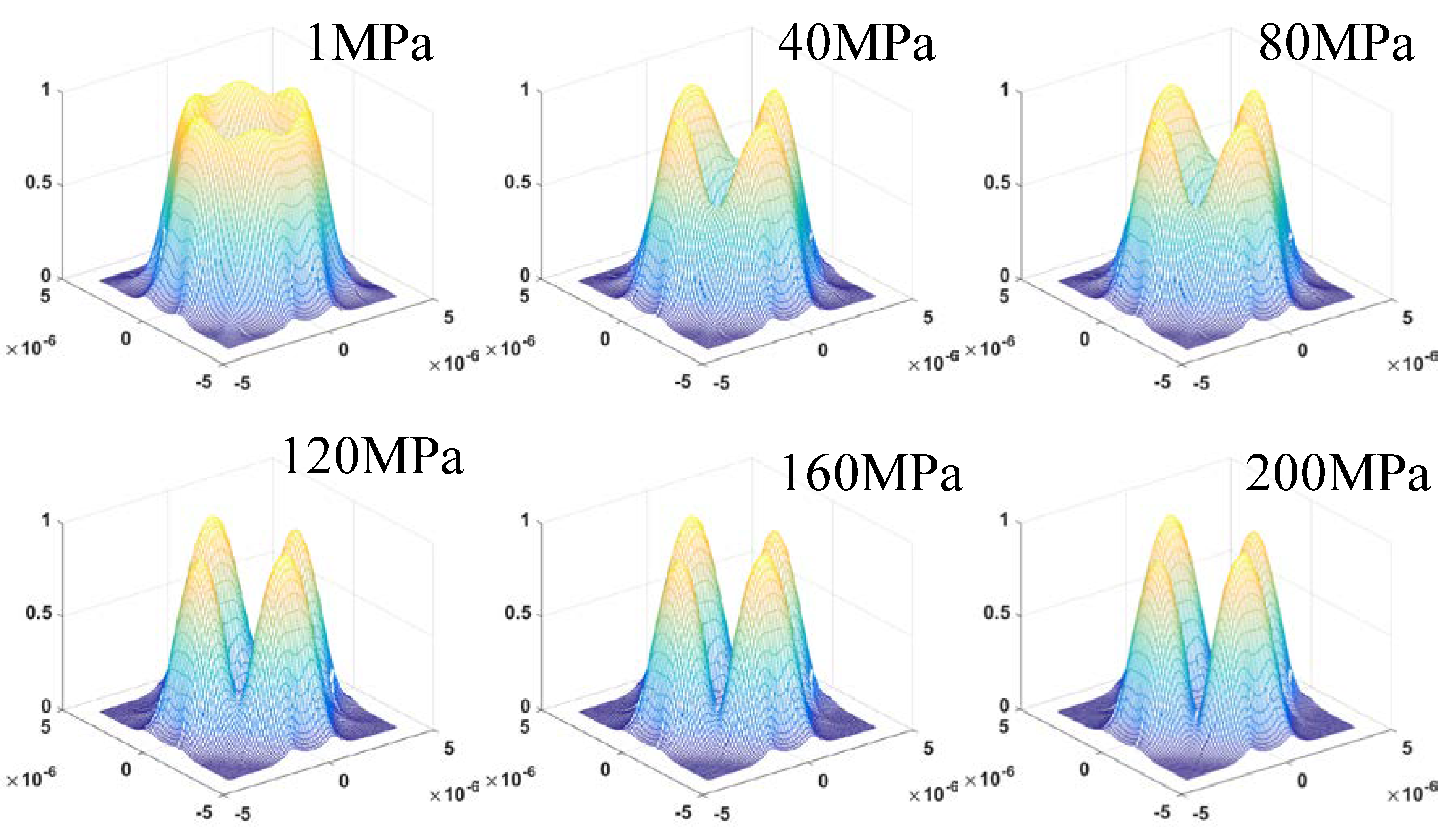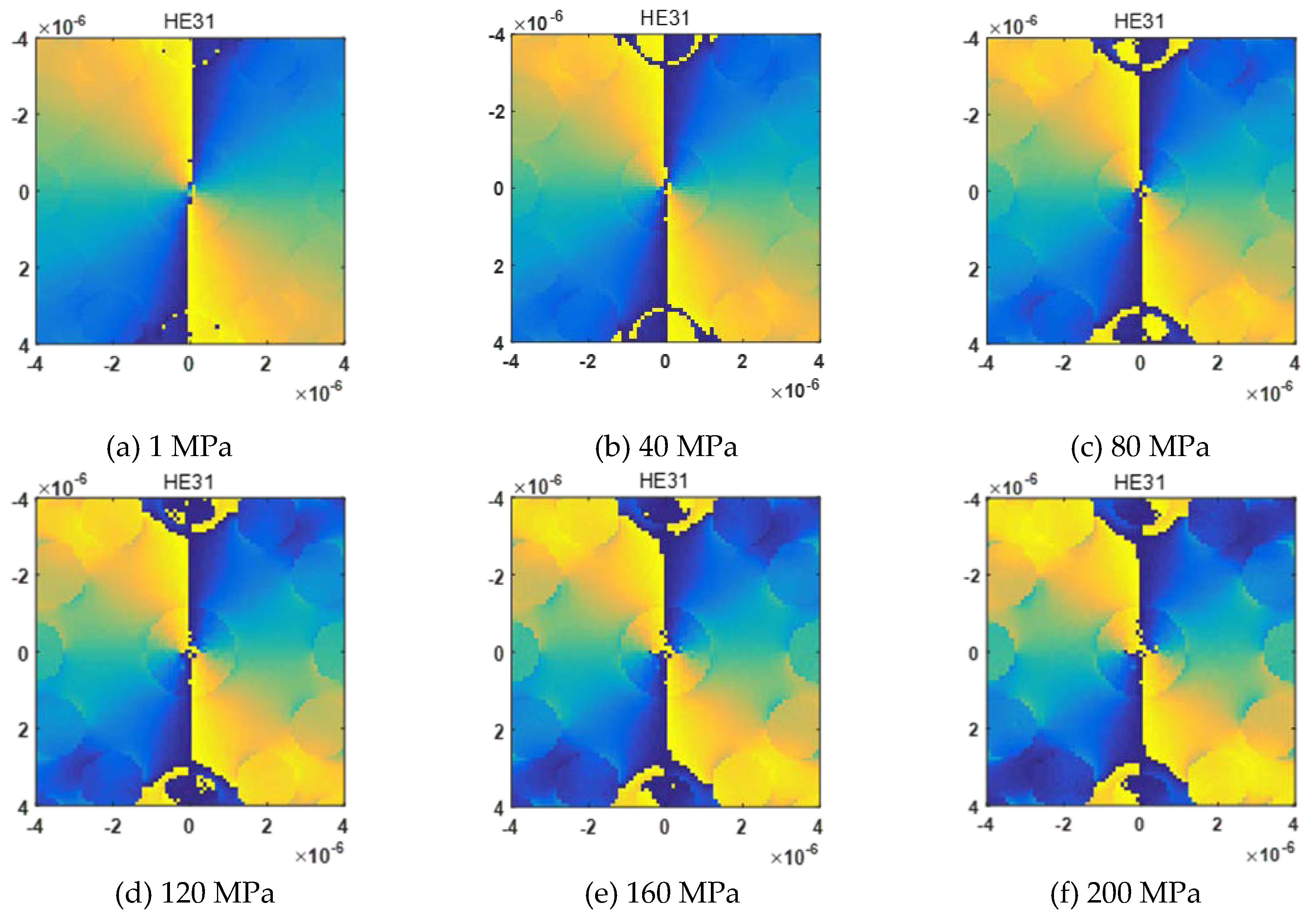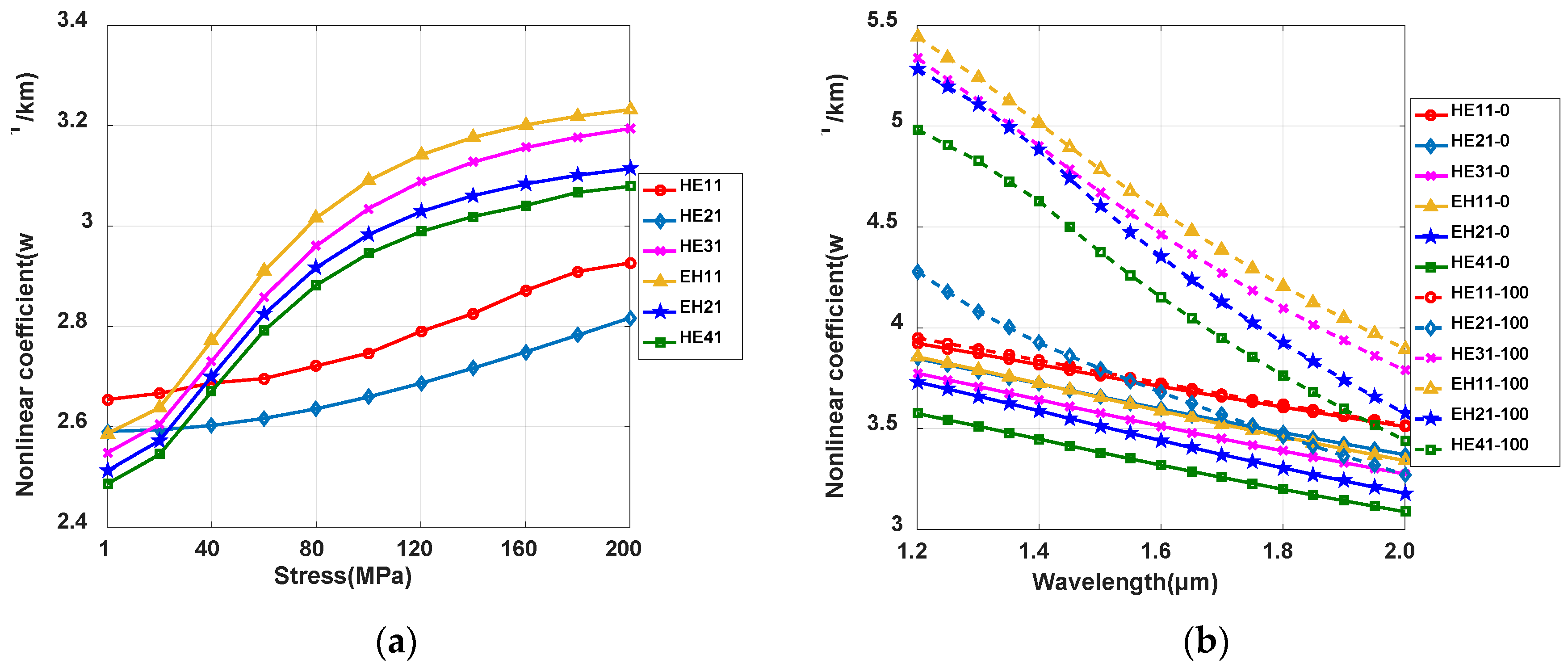Analysis of the Transmission Characteristic and Stress-Induced Birefringence of Hollow-Core Circular Photonic Crystal Fiber
Abstract
:1. Introduction
2. Theoretical Model
2.1. OAM Modes in PCF
2.2. Birefringence Mode Dispersion
3. Simulation and Analysis
3.1. Model of Stress-Induced Field
Effective Refractive Index
3.2. Transmission Characteristics of OAM Modes
3.2.1. Intensity and Phase
3.2.2. Polarization
3.2.3. Loss Characteristics
3.3. Stress-Induced Birefringence
4. Conclusions
Author Contributions
Funding
Conflicts of Interest
References
- Essiambre, R.J.; Kramer, G.; Winzer, P.J.; Foschini, G.J.; Goebel, B. Capacity limits of optical fiber networks. J. Light. Technol. 2010, 28, 662–701. [Google Scholar] [CrossRef]
- Chen, H.; Zhuang, Y. Research progress on key technologies in mode division multiplexing system. J. Nanjing Univ. Posts Telecommun. 2018, 38, 37–44. [Google Scholar]
- Huang, H.; Milione, G.; Lavery, M.P.; Xie, G.; Ren, Y.; Cao, Y.; Ahmed, N.; Nguyen, T.A.; Nolan, D.A.; Li, M.-J.; et al. Mode division multiplexing using an orbital angular momentum mode sorter and MIMO-DSP over a graded-index few-mode optical fiber. Sci. Rep. 2015, 5, 14931. [Google Scholar] [CrossRef] [PubMed]
- Wang, L.; Vaity, P.; Messaddeq, Y.; Rusch, L.; LaRochelle, S. Orbital-angular-momentum polarization mode dispersion in optical fibers and its measurement technique. In Proceedings of the 2015 European Conference on Optical Communication (ECOC), Valencia, Spain, 27 September–1 October 2015. [Google Scholar]
- Puttnam, B.J.; Luís, R.S.; Klaus, W.; Sakaguchi, J.; Mendinueta, J.-M.D.; Awaji, Y.; Wada, N.; Tamura, Y.; Hayashi, T.; Hirano, M.; et al. 2.15 Pb/s transmission using a 22 core homogeneous single-mode multi-core fiber and wideband optical comb. In Proceedings of the 2015 European Conference on Optical Communication (ECOC), Valencia, Spain, 27 September–1 October 2015. [Google Scholar]
- Chu, P.; Sammut, R. Analytical method for calculation of stresses and material birefringence in polarization-maintaining optical fiber. J. Light. Technol. 1984, 2, 650–662. [Google Scholar]
- Tsai, K.H.; Kim, K.S.; Morse, T.F. General solutions for stress-induced polarization in optical fibers. J. Light. Technol. 1991, 9, 7–17. [Google Scholar] [CrossRef]
- Yu, P.; Ji, M. Stress element analysis method of the birefringence in stress- induced fiber. Laser Optoelectron. Prog. 2014, 52, 020604. [Google Scholar]
- Philip, R. Photonic crystal fibers. Science 2003, 299, 358–362. [Google Scholar]
- Yue, Y.; Zhang, L.; Yan, Y.; Ahmed, N.; Yang, J.; Huang, H.; Ren, Y.; Dolinar, S.; Tur, M.; Willner, A.E. Octave-spanning supercontinuum generation of vortices in an As2S3 ring photonic crystal fiber. Opt. Lett. 2012, 37, 1889–1891. [Google Scholar] [CrossRef] [PubMed]
- St Russell, P.; Beravat, R.; Wong, G.K.L. Helically twisted photonic crystal fibres. Philosophical Transactions of the Royal Society A: Mathematical. Phys. Eng. Sci. 2017, 375, 20150440. [Google Scholar] [CrossRef] [PubMed]
- Zhang, L.; Wei, W.; Zhang, Z.; Liao, W.; Yang, Z.; Fan, W.; Li, Y. Propagation properties of vortex beams in a ring photonic crystal fiber. Acta Phys. Sin. 2017, 66, 014205. [Google Scholar]
- Tian, W.; Zhang, H.; Zhang, X.; Xi, L.; Zhang, W.; Tang, X. A circular photonic crystal fiber supporting 26 OAM modes. Opt. Fiber Technol. 2016, 30, 184–189. [Google Scholar] [CrossRef]
- Park, Y.; Paek, U.; Kim, D.Y. Determination of stress-induced intrinsic birefringence in a single-mode fiber by measurement of the two-dimensional stress profile. Opt. Lett. 2002, 27, 1291–1293. [Google Scholar] [CrossRef] [PubMed]
- Galtarossa, A.; Palmieri, L.; Schiano, M.; Tambosso, T. Statistical characterization of fiber random birefringence. Opt. Lett. 2000, 25, 1322–1324. [Google Scholar] [CrossRef] [PubMed]
- Wang, L.; Vaity, P.; Chatigny, S.; Messaddeq, Y.; Rusch, L.A.; LaRochelle, S. Orbital-Angular-Momentum Polarization Mode Dispersion in Optical Fibers. J. Light. Technol. 2014, 34, 1661–1671. [Google Scholar] [CrossRef]
- Brunet, C.; Ung, B.; Wang, L.; Messaddeq, Y.; LaRochelle, S.; Rusch, L.A. Design of a family of ring-core fibers for OAM transmission studies. Opt. Express 2015, 23, 10553–10563. [Google Scholar] [CrossRef] [PubMed]
- Bréchet, F.; Marcou, J.; Pagnoux, D.; Roy, P. Complete analysis of the characteristics of propagation into photonic crystal fibers, by the finite element method. Opt. Fiber Technol. 2000, 6, 181–191. [Google Scholar] [CrossRef]
- Willner, A.E.; Huang, H.; Yan, Y.; Ren, Y.; Ahmed, N.; Xie, G.; Bao, C.; Li, L.; Cao, Y.; Zhao, Z.; Wang, J.; et al. Optical communications using orbital angular momentum beams. Adv. Opt. Photonics 2015, 7, 66–106. [Google Scholar] [CrossRef]
- Brunet, C.; Vaity, P.; Messaddeq, Y.; LaRochelle, S.; Rusch, L.A. Design, fabrication and validation of an OAM fiber supporting 36 states. Opt. Express 2014, 22, 26117–26127. [Google Scholar] [CrossRef] [PubMed]
- Menyuk, C.R.; Wai, P.K.A. Polarization evolution and dispersion in fibers with spatially varying birefringence. J. Opt. Soc. Am. B 1994, 11, 1288–1296. [Google Scholar] [CrossRef]
- Bakhshali, A.; Chan, W.Y.; Cartledge, J.C.; O’Sullivan, M.; Laperle, C.; Borowi, A. Frequency-Domain Volterra-Based Equalization Structures for Efficient Mitigation of Intrachannel Kerr Nonlinearities. J. Light. Technol. 2016, 34, 1770–1777. [Google Scholar] [CrossRef]
- Shibata, N.; Okamoto, K.; Tateda, M.; Seikai, S.; Sasaki, Y. Modal birefringence and polarization mode dispersion in single-mode fibers with stress-induced anisotropy. IEEE J. Quant. Electron. 1989, 19, 1110–1115. [Google Scholar] [CrossRef]
- Zhang, H.; Zhang, W.; Xi, L.; Tang, X.; Zhang, X.; Zhang, X. A New Type Circular Photonic Crystal Fiber for Orbital Angular Momentum Mode Transmission. IEEE Photonics Technol. Lett. 2016, 28, 1426–1429. [Google Scholar] [CrossRef]
- Zhang, H.; Zhang, X.; Li, H.; Deng, Y.; Zhang, X.; Xi, L.; Tang, X.; Zhang, W. A design strategy of the circular photonic crystal fiber supporting good quality orbital angular momentum mode transmission. Opt. Commun. 2017, 397, 59–66. [Google Scholar] [CrossRef]
- Li, H.; Zhang, H.; Zhang, X.; Deng, Y.; Xi, L.; Tang, X.; Zhang, W. Design tool for circular photonic crystal fibers supporting orbital angular momentum modes. Appl. Opt. 2018, 57, 2474–2481. [Google Scholar]
- Zhu, Z.; Brown, T.G. Stress-induced birefringence in micro structured optical fibers. Opt. Lett. 2003, 28, 2306–2308. [Google Scholar] [CrossRef] [PubMed]
- Schreiber, T.; Schultz, H.; Schmidt, O.; Röser, F.; Limpert, J.; Tünnermann, A. Stress-induced birefringence in large-mode-area micro-structured optical fibers. Opt. Express 2005, 13, 3637–3646. [Google Scholar] [CrossRef] [PubMed]
- Zhang, Z.; Gan, J.; Heng, X.; Wu, Y.; Li, Q.; Qian, Q.; Chen, D.; Yang, Z. Optical fiber design with orbital angular momentum light purity higher than 99.9%. Opt. Express 2015, 23, 29331–29341. [Google Scholar] [CrossRef] [PubMed]
- Xu, H.; Wu, J.; Xu, K.; Dai, Y.; Xu, C.; Lin, J. Ultra-flattened chromatic dispersion control for circular photonic crystal fibers. J. Opt. 2011, 13, 994–1001. [Google Scholar] [CrossRef]
- Varnham, M.P.; Payne, D.N.; Barlow, A.J.; Birch, R.D. Analytic solution for the birefringence produced the thermal stress in polarization-maintaining optical fibres. J. Light. Technol. 1983, LT-1, 332–339. [Google Scholar] [CrossRef]
- Maji, P.S.; Chaudhuri, P.R. Circular photonic crystal fibers: Numerical analysis of chromatic dispersion and losses. ISRN Opt. 2013, 2013, 986924. [Google Scholar] [CrossRef]
- Tandjè, A.; Yammine, J.; Bouwmans, G.; Dossou, M.; Vianou, A.; Andresen, E.R.; Bigot, L. Design and Fabrication of a Ring-Core Photonic Crystal Fiber for Low-Crosstalk Propagation of OAM Modes. In Proceedings of the 2018 European Conference on Optical Communication (ECOC), Rome, Italy, 23–27 September 2018. [Google Scholar]

















| parameter | Value | Units |
|---|---|---|
| Refractive index | 1.444 | — |
| Young’s modulus | 7.8×1010 | Pa |
| Poisson's ratio | 0.17 | — |
| wavelength | 1.55 | μm |
© 2019 by the authors. Licensee MDPI, Basel, Switzerland. This article is an open access article distributed under the terms and conditions of the Creative Commons Attribution (CC BY) license (http://creativecommons.org/licenses/by/4.0/).
Share and Cite
Yang, J.; Zhang, H.; Zhang, X.; Li, H.; Xi, L. Analysis of the Transmission Characteristic and Stress-Induced Birefringence of Hollow-Core Circular Photonic Crystal Fiber. Crystals 2019, 9, 128. https://doi.org/10.3390/cryst9030128
Yang J, Zhang H, Zhang X, Li H, Xi L. Analysis of the Transmission Characteristic and Stress-Induced Birefringence of Hollow-Core Circular Photonic Crystal Fiber. Crystals. 2019; 9(3):128. https://doi.org/10.3390/cryst9030128
Chicago/Turabian StyleYang, Jingxuan, Hu Zhang, Xiaoguang Zhang, Hui Li, and Lixia Xi. 2019. "Analysis of the Transmission Characteristic and Stress-Induced Birefringence of Hollow-Core Circular Photonic Crystal Fiber" Crystals 9, no. 3: 128. https://doi.org/10.3390/cryst9030128





